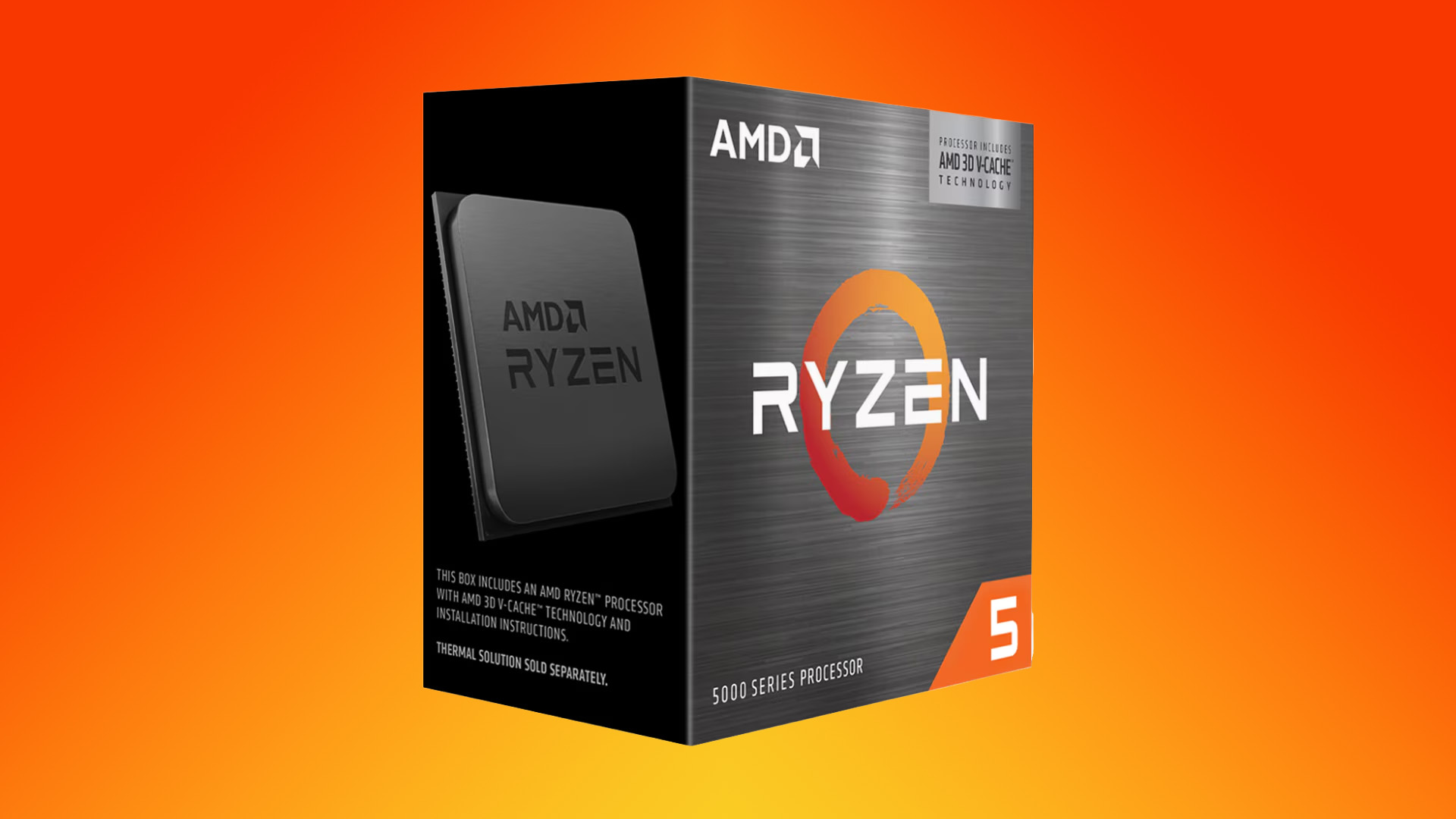AMD's new budget AM4 gaming CPU looks solid in new benchmarks — Zen 3-based Ryzen 5 5500X3D trails Ryzen 5 5600X3D by 6% in PassMark
Is the Ryzen 5 5500X3D affordable enough to sell in Latin America?

AMD recently introduced the Ryzen 5 5500X3D to contend with the best CPUs in the market. Thanks to X user X86 is dead&back, the initial benchmark results for this Zen 3 processor with 3D V-Cache have been unearthed.
The Ryzen 5 5500X3D belongs to the Ryzen 5000 (codenamed Vermeer) series, utilizing Zen 3 execution cores. With AMD already on Zen 5, it may be surprising to some that the chipmaker continues to release processors that are two generations behind. Zen 3 should be cheap to produce now, so AMD can pump them out without affecting its books. Notably, the Ryzen 5 5500X3D is exclusively available in Latin America, serving as a product tailored for price-sensitive markets.
It doesn't take long to realize that the Ryzen 5 5500X3D is essentially a lower-binned version of the Ryzen 5 5600X3D. Both chips maintain a six-core, 12-thread configuration; however, the Ryzen 5 5500X3D features lower clock speeds. It's not a huge difference, though. We're looking at a 9% lower base and boost clocks. The two Zen 3-powered chips also offer the same 96MB L3 cache and are rated for 105W of power.
AMD Ryzen 5 5500X3D Benchmarks
Processor | PassMark Single-Thread Rating | PassMark Multi-Thread Rating | PassMark Samples |
|---|---|---|---|
Ryzen 5 9600 | 4,293 | 28,761 | 31 |
Ryzen 5 7600 | 3,909 | 27,038 | 4,265 |
Ryzen 5 5600 | 3,257 | 21,541 | 9,599 |
Ryzsen 5 5600X3D | 3,187 | 21,891 | 182 |
Ryzen 5 5500X3D | 3,005 | 20,498 | 1 |
Ryzen 5 5500 | 3,058 | 19,324 | 7,533 |
Before we proceed with the PassMark benchmarks, please be advised that the Ryzen 5 5500X3D is represented by only a single result; consequently, the margin for error is significant. In comparison, the results for the other comparable chips are derived from considerably larger sample sizes, thereby providing a more accurate indication of real-world performance.
The Ryzen 5 5500X3D exhibited approximately 6% lower performance compared to the Ryzen 5 5600X3D in both single-threaded and multi-threaded evaluations. The same processor showed comparable single-threaded performance to the Ryzen 5 5500 (Cezanne) in single-threaded tasks, while achieving a 6% higher multi-threaded performance. AMD's 3D V-Cache technology is particularly advantageous in gaming; therefore, PassMark benchmarks may not provide the most accurate look at the Ryzen 5 5500X3D. Nonetheless, due to the current lack of gaming-oriented benchmarks for the Ryzen 5 5500X3D, the available PassMark benchmark provides a glimpse into what the budget Zen 3 with 3D V-Cache can do in a non-gaming scenario.
Mexican retailer DD Tech has listed the Ryzen 5 5500X3D for $185.92; concurrently, Argentine retailer Tecnocraft offers the same processor for $184.66, exclusive of VAT (value-added tax). Given the similarity in pricing between these two vendors, it is reasonable to infer that the MSRP for the Ryzen 5 5500X3D is approximately $185. The pricing appears to be appropriate for foreign markets, where hardware products generally command higher prices. However, within the U.S. market, the Ryzen 5 5500X3D is a hard pass, considering that consumers can acquire a Ryzen 5 7600X for as low as $178 or opt for the latest Ryzen 5 9600X, starting at $197.
Follow Tom's Hardware on Google News to get our up-to-date news, analysis, and reviews in your feeds. Make sure to click the Follow button.
Get Tom's Hardware's best news and in-depth reviews, straight to your inbox.

Zhiye Liu is a news editor, memory reviewer, and SSD tester at Tom’s Hardware. Although he loves everything that’s hardware, he has a soft spot for CPUs, GPUs, and RAM.
-
usertests Just a reflection of what we already knew, the 5500X3D is a low-clocking Zen 3 part.Reply
Low-end Zen 6 X3D could be interesting since it should either have 10 or 8 cores, demolishing the 9800X3D either way with 50% higher cache and probably higher clocks. -
helper800 Reply
Do you have a source for an increased cache amount on X3D CPUs?usertests said:Just a reflection of what we already knew, the 5500X3D is a low-clocking Zen 3 part.
Low-end Zen 6 X3D could be interesting since it should either have 10 or 8 cores, demolishing the 9800X3D either way with 50% higher cache and probably higher clocks. -
usertests Reply
https://www.tomshardware.com/pc-components/cpus/amd-6th-gen-epyc-9006-venice-cpus-reportedly-offer-up-to-96-zen-6-or-256-zen-6c-coreshttps://www.guru3d.com/story/amd-3d-cache-and-core-evolution-from-64-mb-to-96-mb-in-zen-6-cpus/helper800 said:Do you have a source for an increased cache amount on X3D CPUs?
There are multiple sources for both but you can start with that.
It has been repeatedly leaked that Zen 6 desktop CPUs ("Olympic Ridge") will use a 12-core CCD with 48 MiB of L3 cache, instead of the current 8-core CCD with 32 MiB of L3 cache. So right out of the gate, a standard CPU gets 50% of a 9800X3D's cache instead of 33%.
AMD is apparently increasing the cache chiplet proportionately. Meaning a 96 MiB cache chiplet instead of the current 64 MiB, adding up to 144 MiB total for one CCD.
So basically, Zen 6 = +50% cache. 48 MiB on standard CPUs instead of 32 MiB, 144 MiB on X3D instead of 96 MiB.
We may see dual-X3D parts, but the total amount across two CCDs doesn't matter that much, it just makes scheduling the threads painless. -
helper800 Reply
But that means it gets the exact same cache per core. Do we know if all the cores can address all of the L3 cache tile(s) within a CCD? I assume they can, so it would be an effective increase in cache available to each core at any time.usertests said:https://www.tomshardware.com/pc-components/cpus/amd-6th-gen-epyc-9006-venice-cpus-reportedly-offer-up-to-96-zen-6-or-256-zen-6c-coreshttps://www.guru3d.com/story/amd-3d-cache-and-core-evolution-from-64-mb-to-96-mb-in-zen-6-cpus/
There are multiple sources for both but you can start with that.
It has been repeatedly leaked that Zen 6 desktop CPUs ("Olympic Ridge") will use a 12-core CCD with 48 MiB of L3 cache, instead of the current 8-core CCD with 32 MiB of L3 cache. So right out of the gate, a standard CPU gets 50% of a 9800X3D's cache instead of 33%. -
usertests Reply
It is the same cache per core on a CCD, raised in proportion with the core count increase, but many applications and games in particular are doing most of their work on a couple of cores. Having any of the cores capable of using up to 48 MiB or 144 MiB is going to be a major improvement.helper800 said:But that means it gets the exact same cache per core. Do we know if all the cores can address all of the L3 cache tile(s) within a CCD? I assume they can, so it would be an effective increase in cache available to each core at any time.
48 MiB is on die, 96 MiB on cache chiplet, a core on the CCD can access it all but not access another CCD's L3 because latency would be too high. The way it works is unchanged from previous generations. AMD/TSMC can supposedly create dual-layer cache chiplets which could bring a single CCD to 240 MiB, but it's nothing that we can expect to see in the consumer CPUs. Maybe a special Epyc SKU?
Maybe in the future, multiple CCDs can have their L3 cache bridged together into one giant cache blob hiding under the cores, but not yet. Eventually moving all the L3 cache off of CCDs could be a good idea because SRAM scales poorly on advanced nodes.
I predicted Zen 6 would only have 36 MiB, lessening the divided cache per core from 4 MiB to 3 MiB each (not a useful number IMO, see first paragraph), so they already exceeded my expectations. -
levia.dragon Reply
There is cross CCD latency. The reason why there is a game mode disabling one CCD.usertests said:https://www.tomshardware.com/pc-components/cpus/amd-6th-gen-epyc-9006-venice-cpus-reportedly-offer-up-to-96-zen-6-or-256-zen-6c-coreshttps://www.guru3d.com/story/amd-3d-cache-and-core-evolution-from-64-mb-to-96-mb-in-zen-6-cpus/
We may see dual-X3D parts, but the total amount across two CCDs doesn't matter that much, it just makes scheduling the threads painless.
As to the impact, that is less obvious and I think will vary from game to game, largely due to how well it can stay on just one CCD.
But I do feel that dual CCD X3D isn't going to be outright better for that reason. -
usertests Reply
There's no work on the part of AMD or the users to decide which CCD to disable for games if they are both the same. Although that only applies to users of non-X3D or the hypothetical dual-cache parts.levia.dragon said:There is cross CCD latency. The reason why there is a game mode disabling one CCD.
As to the impact, that is less obvious and I think will vary from game to game, largely due to how well it can stay on just one CCD.
But I do feel that dual CCD X3D isn't going to be outright better for that reason.
Zen 6 increasing the CCD to 12 cores might have a positive effect on the situation, since it would be harder for a game to "fill" a CCD, but maybe game mode is still needed to keep a game from trying to use a high clocking core on the other CCD. I'm not sure.
One of the leakers claimed that dual-X3D was for better AI inferencing performance:
1952353508893872482View: https://x.com/1usmus/status/1952353508893872482
1952354884549853666View: https://x.com/1usmus/status/1952354884549853666 -
levia.dragon Reply
I have seen so far no benchmarks, or suggestions saying there is any benefit other than gaming, sometimes.usertests said:There's no work on the part of AMD or the users to decide which CCD to disable for games if they are both the same. Although that only applies to users of non-X3D or the hypothetical dual-cache parts.
Zen 6 increasing the CCD to 12 cores might have a positive effect on the situation, since it would be harder for a game to "fill" a CCD, but maybe game mode is still needed to keep a game from trying to use a high clocking core on the other CCD. I'm not sure.
One of the leakers claimed that dual-X3D was for better AI inferencing performance:
1952353508893872482View: https://x.com/1usmus/status/1952353508893872482
1952354884549853666View: https://x.com/1usmus/status/1952354884549853666
If there is a benefit to AI, it is the first time I have heard of there being a non-gaming workload that benefits.
Though the creators testing this certainly didn't have any AI benchmarks, rather gaming, productivity and production.
A game filling a CCD, and staying on one CCD is doing what it is meant to be doing, when the performance hit usually comes from being split over two, regardless of X3D or not. -
usertests Reply
There are obviously non-gaming workloads that benefit from increased L3 cache. If there wasn't, then AMD wouldn't be selling an Epyc chip like the 9684X, which has not one, but TWELVE cache chiplets, for a total of 1152 MiB L3 (still split up into 96 MiB chunks as usual).levia.dragon said:I have seen so far no benchmarks, or suggestions saying there is any benefit other than gaming, sometimes.
If there is a benefit to AI, it is the first time I have heard of there being a non-gaming workload that benefits.
As for what they are, Phoronix can give you an idea. One example is that in an nginx (server) benchmark, 9950X3D jumps 18% ahead of the 9950X, also moving above the 285K at the same time. About a third of all websites use nginx, so that use case alone could justify lots of Epyc + V-Cache deployments.
For AI, I can see that it helps massively in some OpenVINO benchmarks, with some smaller gains in Whisper.cpp (transcription, recently included in FFmpeg 8.0), Llama.cpp, and ONNX.
Summary of all results here: https://www.phoronix.com/review/amd-ryzen-9-9950x3d-linux/10